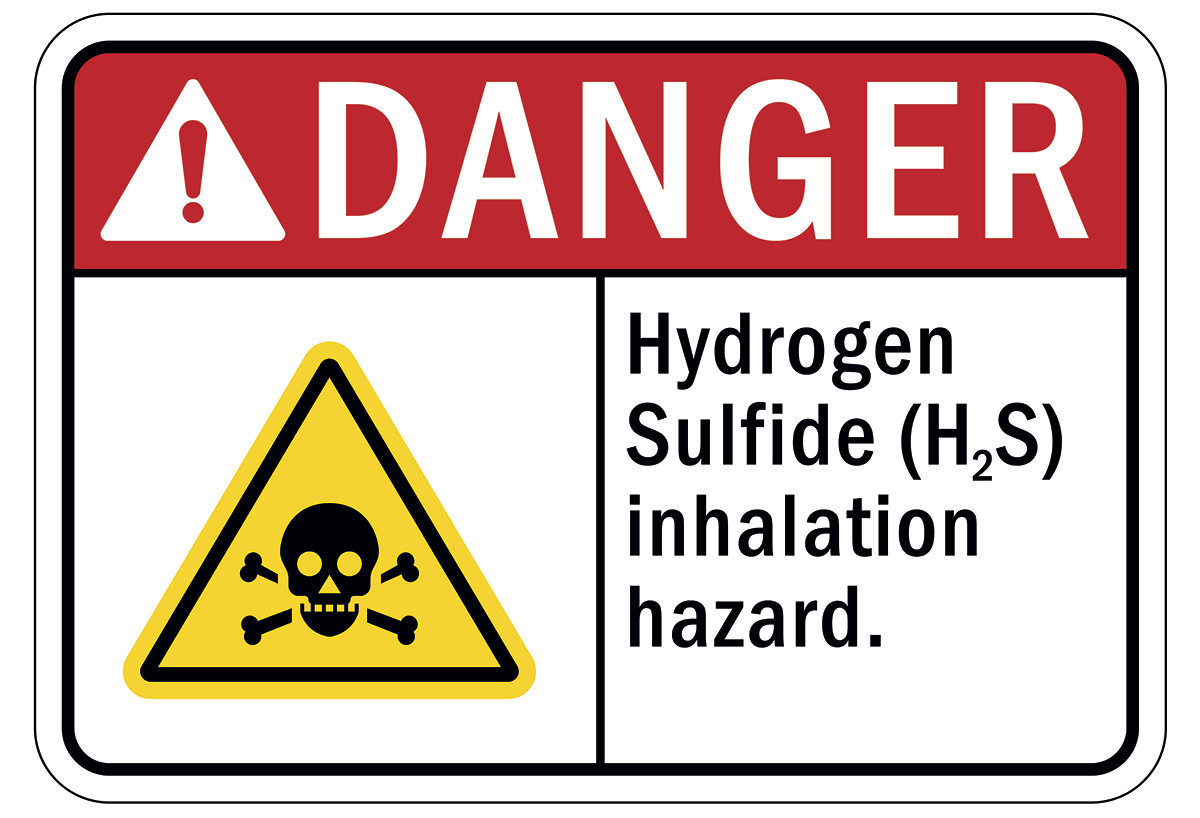
What You Need to Know About Hydrogen Sulfide (H2S)

What is Hydrogen Sulfide?
Hydrogen sulfide (H2s) is a colorless and highly dangerous gas characterized by its foul "rotten egg" odor. It can be found naturally in crude petroleum, natural gas, and hot springs. Various industrial processes, including petroleum and natural gas extraction, refining, wastewater treatment, coke oven operations, tanneries, and kraft paper mills, can also emit this gas.
H2S is an extremely irritating gas. Fast recognition and detection are paramount to safeguard employees from its lethal effects. Individuals working in areas where hydrogen sulfide is present or likely to be present should be trained on recognizing the signs and symptoms of hydrogen sulfide exposure, monitoring for its presence, and implementing protective measures.
H2S is an extremely irritating gas. Fast recognition and detection are paramount to safeguard employees from its lethal effects. Individuals working in areas where hydrogen sulfide is present or likely to be present should be trained on recognizing the signs and symptoms of hydrogen sulfide exposure, monitoring for its presence, and implementing protective measures.
How is Hydrogen Sulfide Detected?
Monitoring instruments are readily available to continuously assess the atmosphere in confined spaces for hydrogen sulfide and other gases, as well as oxygen levels. The Occupational Safety and Health Administration (OSHA) regulates hydrogen sulfide, setting a permissible exposure limit of 20 parts per million (ppm) as a ceiling concentration and a peak exposure limit of 50 ppm for no more than 10 minutes in the absence of other measurable exposures. Inhalation of concentrations ranging from 500 to 1000 ppm results in rapid unconsciousness and death due to respiratory paralysis and asphyxiation. Hydrogen sulfide is heavier than air and collects along the ground especially poorly ventilated areas such as basements, manholes, etc.
Toxicity
H2S can adversely affect the body through inhalation, contact with the eyes, skin, nose, or throat, and even ingestion. Inhalation of low concentrations may lead to symptoms like headaches, dizziness, and upset stomach. Higher concentrations can induce loss of consciousness and fatal outcomes. Hydrogen sulfide emits a pungent odor reminiscent of rotten eggs at low concentrations and a sweeter odor at higher levels. However, relying on odor as a warning is unreliable, as concentrations in the range of 20-30 ppm can numb the sense of smell by affecting the respiratory center of the brain and the olfactory nerve.
What are the Health Effects of Hydrogen Sulfide?
Low-level exposures are common in industrial settings and may produce local eye and mucous membrane irritation, mild systemic effects, and chemical bronchitis with repeated exposure. Upon examination of an individual, evidence of conjunctivitis and wheezing with gray-green lime on the gingiva from long-term exposures.
Low Exposure
• Eye irritation can develop at concentrations as low as 4 ppm
• Pulmonary membrane irritation is evident with exposures greater than 20 ppm
Higher Level Exposure (50 - 400 ppm)
• Severe cardiopulmonary and systemic effects
Severe High Level Exposure (> 500 ppm)
• Fatal systemic toxicity
Low Exposure
• Eye irritation can develop at concentrations as low as 4 ppm
• Pulmonary membrane irritation is evident with exposures greater than 20 ppm
Higher Level Exposure (50 - 400 ppm)
• Severe cardiopulmonary and systemic effects
• Continued exposure results in pulmonary edema
Severe High Level Exposure (> 500 ppm)
• Fatal systemic toxicity
• Just a few breaths of H2S at > 700 ppm will bring immediate death
Personal Protective Equipment
For protection against hydrogen sulfide gas, two types of respiratory equipment are deemed acceptable: Self-Contained Breathing Apparatus (SCBA) or Supplied Airline Respirators. Respiratory protection should only be employed when engineering controls are infeasible for managing hydrogen sulfide gas exposure.
While there have been numerous workplace fatalities linked to hydrogen sulfide gas, adequate training, the use of monitoring equipment, and adherence to safety and health procedures for entering confined spaces can enable employees to work safely without incident when encountering hydrogen sulfide gas, whether at reservoirs, dams, or other locations.
While there have been numerous workplace fatalities linked to hydrogen sulfide gas, adequate training, the use of monitoring equipment, and adherence to safety and health procedures for entering confined spaces can enable employees to work safely without incident when encountering hydrogen sulfide gas, whether at reservoirs, dams, or other locations.
Treatment Protocol
Individuals exposed to H2S gas should promptly remove themselves from the hazardous environment. Caution is advised for rescuers approaching individuals who are unable to evacuate independently, as they risk H2S exposure and potential harm. It is strongly recommended that respiratory protection be worn when entering an environment contaminated with H2S gas, along with the use of a safety line, due to the rapid and severe toxic effects of the gas. While there are no established antidotes for H2S gas poisoning, healthcare providers can manage and address its side effects and symptoms. In severe cases, hospitalization may become necessary.
As per the guidelines provided by the Agency for Toxic Substances and Disease Registry (ATSDR), it is advisable to contact your healthcare professional or seek emergency medical attention if you experience any unusual side effects or symptoms within a 24-hour period:
As per the guidelines provided by the Agency for Toxic Substances and Disease Registry (ATSDR), it is advisable to contact your healthcare professional or seek emergency medical attention if you experience any unusual side effects or symptoms within a 24-hour period:
1. Coughing, wheezing, difficulty breathing, or shortness of breath
2. Chest pain or a feeling of tightness in the chest
3. Stomach pain or vomiting
4. Headache
5. Increased redness, pain, or pus from the site of a skin burn
Related Articles
Write your awesome label here.

